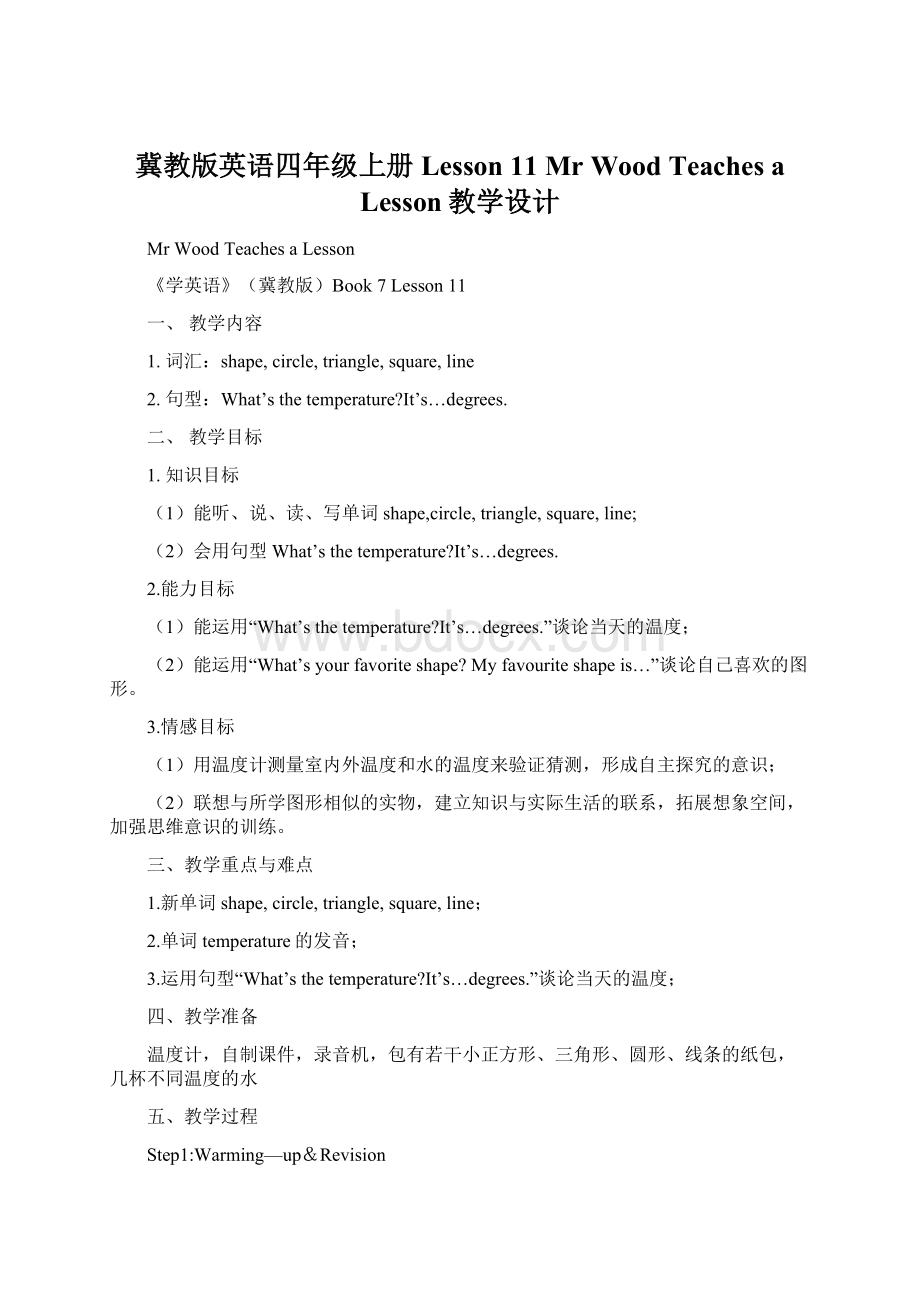冀教版英语四年级上册Lesson 11 Mr Wood Teaches a Lesson教学设计.docx
《冀教版英语四年级上册Lesson 11 Mr Wood Teaches a Lesson教学设计.docx》由会员分享,可在线阅读,更多相关《冀教版英语四年级上册Lesson 11 Mr Wood Teaches a Lesson教学设计.docx(8页珍藏版)》请在冰豆网上搜索。

冀教版英语四年级上册Lesson11MrWoodTeachesaLesson教学设计
MrWoodTeachesaLesson
《学英语》(冀教版)Book7Lesson11
一、教学内容
1.词汇:
shape,circle,triangle,square,line
2.句型:
What’sthetemperature?
It’s…degrees.
二、教学目标
1.知识目标
(1)能听、说、读、写单词shape,circle,triangle,square,line;
(2)会用句型What’sthetemperature?
It’s…degrees.
2.能力目标
(1)能运用“What’sthetemperature?
It’s…degrees.”谈论当天的温度;
(2)能运用“What’syourfavoriteshape?
Myfavouriteshapeis…”谈论自己喜欢的图形。
3.情感目标
(1)用温度计测量室内外温度和水的温度来验证猜测,形成自主探究的意识;
(2)联想与所学图形相似的实物,建立知识与实际生活的联系,拓展想象空间,加强思维意识的训练。
三、教学重点与难点
1.新单词shape,circle,triangle,square,line;
2.单词temperature的发音;
3.运用句型“What’sthetemperature?
It’s…degrees.”谈论当天的温度;
四、教学准备
温度计,自制课件,录音机,包有若干小正方形、三角形、圆形、线条的纸包,几杯不同温度的水
五、教学过程
Step1:
Warming—up&Revision
1.师生互致问候,自由交谈。
T:
Hello,boysandgirls.Howareyoutoday?
Ss:
Fine,thanks.Andyou?
T:
I’mverywell,thankyou.TodayIfeelwarm.Howdoyoufeel?
S1:
Ifeelcool.
S2:
Ifeelhot.
S3:
Ifeelwarm,too.
T:
Ifeelwarm,soIwearmyfavoriteclothes—jeans.(toS1)Whatareyourfavoriteclothes?
S1:
Myfavoriteclothesareshirts.
T:
What’syourfavoritecolor?
S1:
Myfavoritecolorispurple.(toS2)Whatareyourfavoriteclothes?
S3:
Myfavoriteclothesaredresses.
S1:
What’syourfavoritecolor?
S2:
Myfavoritecolorisred.
【设计说明】
通过师生间的自然交谈,复习了“What’syourfavorite…?
Myfavorite…is/are…”这两个句型,为之后学习“What’syourfavoriteshape?
Myfavoriteshapeis…”做好了铺垫。
2.教师用课件呈现一张各地天气预报图,引导学生用英语谈论各地的天气状况。
T:
Look,thisisamapoftheweatherforecastfortoday.How’stheweatherinBeijing?
S1:
It’ssunny.
T:
(手指图中北京的温度)HowdoyoufeelinBeijing?
S2:
Ifeelwarm.
S3:
Ifeelhot.
教师指向其他城市的温度,引导学生用“It’s…Ifeel…”回答。
【设计说明】
以天气预报的形式引导学生复习有关天气特征的表达方式,不仅增加了学习活动的趣味性,而且让学生感受了不同城市的气温,为之后学习新的内容做好铺垫。
用天气预报图把所学知识与实际生活相联系,有利于培养学生用所学知识解决实际问题的能力真正做到学以致用。
Step2.Presentation&Practice
(1)
1.通过与学生谈论教室内外的温度,引入对新知识的学习。
T:
Howdoyoufeelinsideourclassroom?
Ss:
Wefeelwarm.
T:
Ifeelwarm,too.What’sthetemperature?
(拿出温度计)What’sthetemperatureinsidetheclassroom?
(请一位学生读出温度计上的数值。
)
Ss:
Eighteen.
T:
What’sthetemperature?
It’seighteendegrees.
Ss:
What’sthetemperature?
It’seighteendegrees.
T:
Pleaseguess,what’sthetemperatureoutsidetheclassroom?
S1It’ssixteendegrees.
S2:
It’sfoureendegrees.
S3:
It’sfifteendegrees.
…
教师把温度计放在教室外,几分钟后拿回温度计,并让一位学生读出温度计上显示的数值。
T:
What’sthetemperatureoutside?
S1:
It’sfifteendegrees.
【设计说明】
教师先与学生谈论天气情况以及自己在某种天气状况下的感受,然后让学生根据温度计上显示的信息理解单词temperature的含义,这样就把新知识的学习与旧知识的复习紧密结合起来,让学生在原有知识和经验的基础上,理解和掌握本节课的教学重点和难点。
2.测量一杯水的水温,在此过程中操练新学的知识。
T:
Look.Hereisaglassofwater.It’sveryhot.What’sthetemperatureofthewater?
S1It’ssixtydegrees.
S2:
It’seightydegrees.
S3:
It’sninetydegrees.
…
教师用温度计测量水温,并请一位学生读出温度计上的数值。
T:
What’sthetemperature?
S1:
It’sninety--twodegrees.
学生分成四人学习小组,教师拿出几杯不同温度的水,分给每个小组一杯水和一个温度计;学生在小组内用温度计测量水的温度,并用“What’sthetemperature?
It’s…degrees.”进行对话。
如果教具充足的话,这个活动也可以采用两人一组的形式开展。
学生活动期间,教师巡回指导,并特别注意学生对temperature的发音。
【设计说明】
通过让学生测量水的温度,加深他们对新学知识的感悟,让学生接近真实的语境中操练新学知识。
3.让学生听录音,帮助学生在理解课文内容。
在让学生听录音前,教师提出以下问题让学生思考:
What’stheweatherliketoday?
What’sthetemperatureinsidetheclassroom?
What’sthetemperatureoutsidetheclassroom?
What’sthetemperatureofthehotwater?
学生听完录音后,师生一起核对答案。
【设计说明】
让学生带着问题听录音和读课文,有助于集中学生听和读的注意力,提高课堂教学的实效;另外,开放式的问题情境能启发学生的思维,为学生的语言表达提供更大的空间。
4.知识运用
教师用课件呈现一张天气预报图,并做播报天气预报的示范。
T:
ThiscityisBaoji.Itissunnytoday.What’sthetemperature?
It’seighteendegrees.YoumayfeelwarminBaoji.Youcandosomerunninginthemorning.
教师让学生模仿示范,播报全国各城市的天气预报。
S1:
ThiscityisShijiazhuang.Itissunny,too.What’sthetemperature?
It’stwenty--fivedegrees.It’shotinthiscity.Youcanwearshirts,blouseandcoats.Maybeyou
Canweardressesintheafternoon.
Ss:
ThiscityisHangzhou.Itisrainy.What’sthetemperature?
It’stwenty—twodegrees.Pleasedon’tforgettotakeyourumbrellaandraincoat.
…
【设计说明】
让学生利用已学知识,结合新学知识进行创造性的语言整合及输出,激发学生的创新思维,充分体现教学的层次性,让学生在活动中体验学习成功的快乐。
Step3.Presentation&Practice
(2)
1.导入并介绍新知识。
T:
Thetemperatureiscomfortable.Ifeelgood,soIwanttolearnEnglishwithme?
Ss:
Yes.
T:
(用课件呈现一条直线)What’sthis?
Ss:
直线。
T:
It’saline.(再次用课件呈现一条直线)
What’sthis?
Ss:
It’saline.
T:
Whatlookslikealine?
什么东西的形状像直线啊?
S1:
Pencil.
S2:
Ruler.
S3:
Noodles.
…
T:
(用课件呈现三条直线)What’rethese?
Ss:
Theyarelines.
T:
Howmanylines?
Ss:
Threelines.
T:
Yes.Youareright.
(教师用课件展示三条直线组成一个三角形的过程。
)
T:
What’sthisnow?
Ss:
三角形。
T:
It’satriangle.(再次用课件呈现一个直线组成一个三角形)What’sthis?
Ss:
It’satriangle.
T:
Whatlookslikeatriangle?
什么东西的形状像三角形啊?
S1:
Pizza.
S2:
Ruler.
S3:
Acat’sear.
…
T:
(用课件呈现四条直线)What’rethese?
Ss:
Theyarefourlines.
(教师用课件展示四条直线组成一个正方形的过程。
)
T:
Look,thisisanewshape.Isitatriangle?
Ss:
No.
T:
Whatisit?
It’sa…(引导学生尝试读单词square。
)
T:
It’sasquare.
T:
Howmanylinesmakeasquare?
Ss:
Fourlinesmakeasquare.
T:
Whatlookslikeasquare?
S1:
Window.
S2:
TV.
S3:
Paper.
…
T:
(指着教室内一个圆形的物品)Whatshapeisthis?
Ss:
圆。
(教师写出单词circle,并让学生尝试拼读。
)
S1:
It’sacircle.
T:
Yes.You’reright.Canyoufindothercirclesinourclassroom?
S1:
XiaoMing’sglasses.
S2:
Thesuninthepicture.
S3:
Eggs.
…
T(指着所有的图形)Theseareshapes.
Ss:
Shapes.
【设计说明】
用课件介绍比较抽象的图形演变过程,让学生清楚地看到这些知识间的联系;用实物介绍图形能转换学生的思维方式,把所学知识与实物联系起来。
在介绍每种图形时,注意引导学生将所学知识与生活中的实物相联系,训练学生用英语思维的能力。
教学circle和square这两个新词时,不急于告诉学生单词的正确读音,而是让学生根据自己已有的语音知识尝试拼读,培养学生的自主学习能力。
2.听录音,跟读课文第2和第3部分。
T:
Youknowtheseareshapes.Doyouhaveafavoriteshape?
What’syourfavoriteshape?
S1:
Myfavoriteshapeisacircle.
S2:
Myfavoriteshapeisatriangle.
S3:
Myfavoriteshapeisasquare.
S4:
Myfavoriteshapeisaline.
…
T:
Guess,what’sDanny’sfavoriteshape?
S1:
Hisfavoriteshapeisasquare.
S2:
Hisfavoriteshapeisacircle..
S3:
Hisfavoriteshapeisaline.
…
T:
Whoisright?
Let’slistentotheaudiotapeandcheck
theanswer.
【设计说明】
与学生谈论最喜欢的图形时一个承前启后的环节,过渡自然,既复习巩固了新知识,又为后续的学习活动做好了准备。
让学生带着问题听课文录音可以提高听的效果。
3.小组活动
学生分为若干组,教师给每组发一个小纸包。
T:
Noweverygrouphasasmallbag.Pleaseopenit.Whatcanyouseeinthebag?
Ss:
Shapes.
教师让学生用纸包中的图形拼出各种图形,比如:
animals,food,toys等,然后让学生用“Wemadea…Ithas…line,…square,…triangle,…circle.”等句子描述拼出的图案。
【设计说明】
通过小组合作的方式,让学生在动手制作的过程中学会用英语交谈,在用英语介绍作品时,有效操练新学知识。
另外,小组活动能培养学生的合作意识,提高学生的合作学习能力。
Step4:
Homework
T:
Youdidagoodjobinthislesson.Hereisyourhomework.Ithinkyoucandoitverywell.
(1)Listentotheweatherforecastfortomorrow.Writedownsomemessageandtalkaboutthesemessagewithyourfriendsnextlesson.
(2)Findouttheshapeatschoolandathomeafterschool;
Tellthemtoothersnextlesson.
【设计说明】
在训练听、说和读的技能的同时,注重培养学生写的能力。
记录下天气预报的某些信息,可以作为课上交流的素材。
这样的作业方式能调动学生的思维,帮助他们形成良好的学习策略。
另外,继续引导学生观察身边的实物,并与所学语言知识相联系,帮助学生自主探究、建构知识体系。